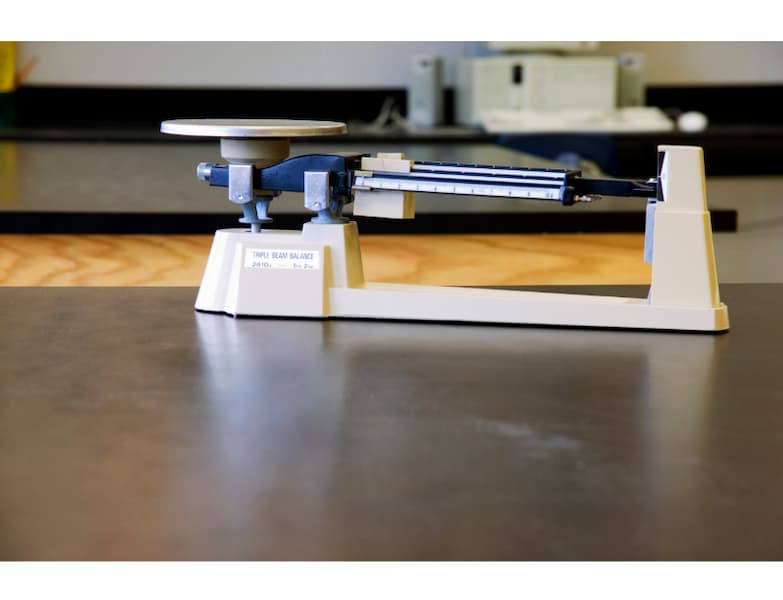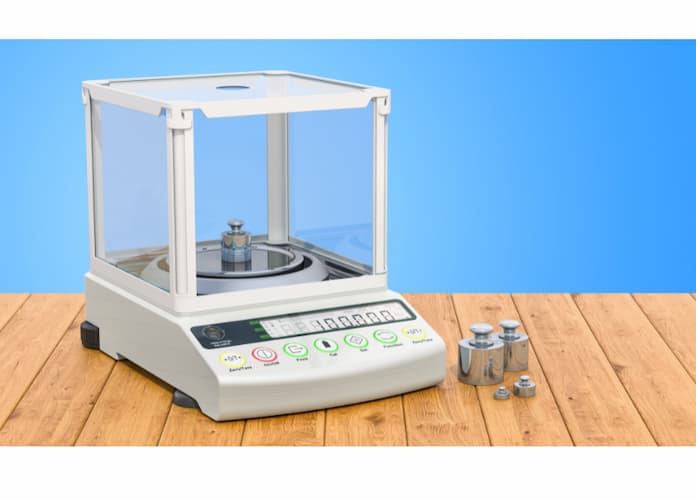
In the world of science, getting accurate measurements is really important. It’s like the foundation of our understanding of things in chemistry, physics, and other scientific fields. To get these measurements right, we use various tools, and two of them are the triple beam balance and the analytical balance.
These are like the superheroes of precise weighing. They help scientists, researchers, and other experts measure things very accurately. We are going to take a closer look at these two heroes and see what they can do.
We’ll explore their strengths, differences, and help you understand which one to use when you need super accurate measurements in your scientific work. So, join us on this journey to discover the world of precise measurement!
The Triple Beam Balance: How It Works

Let’s start with the trusty triple beam balance, a reliable tool that has been used in classrooms and laboratories for decades. But how does it work its magic? Well, it’s all about balance, literally!
Imagine a long bar that sits on a pivot in the middle. This bar has three beams (hence the name “triple beam”), one on the left, one on the right, and one in the middle. Each beam has a pan or tray where you place the object you want to weigh.
When you put an object in one of the pans, the bar tilts because that side becomes heavier. The goal is to balance it out, and you do this by moving small weights along the beams. The weights are marked with numbers, so you can keep track of how much weight you’ve added.
As you add weights to one side, and the object’s weight to the other, you’ll notice the bar starts to level out. Once it’s perfectly horizontal, in balance, you can read the total weight by looking at where each weight marker is on its respective beam.
So, the triple beam balance essentially relies on the principle of balancing weights to measure the mass of an object accurately. It’s simple, yet highly effective, and that’s why it’s been a staple in the world of measurements for so long.
The Analytical Balance: How It Works

Now, let’s turn our attention to the analytical balance, a more modern and sophisticated weighing instrument. Unlike the mechanical simplicity of the triple beam balance, the analytical balance employs advanced technology to achieve unparalleled accuracy.
At its core, an analytical balance functions on the principle of electromagnetic force compensation. It’s a bit like a high-tech magic trick! Here’s how it works:
- Electromagnetic Force: Inside the analytical balance, there is an electromagnet that generates a magnetic field.
- Sample Pan: You place the object you want to weigh in a small pan attached to the balance.
- Balance Beam: There is a balance beam, much like the one in a triple beam balance, but on a much smaller and precise scale. It holds the pan and the object.
- Force Sensor: The real magic happens with a force sensor. This sensor measures the force needed to counteract the weight of your object due to gravity.
- Electromagnetic Coil: The balance contains a coil of wire connected to the pan. When the balance detects an imbalance in weight (thanks to the force sensor), it runs an electric current through this coil. The current creates a magnetic field that opposes the gravitational force acting on your object.
- Weighing and Adjustment: As the electromagnetic force and gravity balance out, the balance can measure the weight of your object very accurately. If your object is slightly too heavy, the balance will adjust the electric current until equilibrium is achieved.
- Digital Display: All this precise measurement is displayed digitally, typically to several decimal places, making it incredibly accurate.
So, while the triple beam balance relies on a simple balance of weights, the analytical balance employs electromagnetic forces to counteract the gravitational pull on the object you’re measuring. This high-tech approach is perfect for scientific applications where precision is absolutely crucial.
Accuracy and Precision in Weighing
When it comes to weighing, accuracy and precision are two essential concepts, but they aren’t quite the same.
Let’s explore what sets them apart and why they matter in the world of scientific measurements.
Accuracy – Imagine you’re shooting arrows at a target. If all your arrows hit the bullseye, you’re incredibly accurate. In weighing, accuracy refers to how close the measurements are to the actual or true value. It’s like hitting that bullseye. So, an accurate measurement is one that’s really close to the exact weight of an object.
Precision – Now, consider the arrows again. If your arrows land very close to each other but not necessarily in the bullseye, you’re precise. Precision in weighing means that your measurements are consistent and the values are very close to each other. Even if they’re not precisely on the exact weight, they’re still reliable and consistent.
To put it simply, you can be precise without being accurate, and you can be accurate without being precise. But the best scenario is when you’re both accurate and precise, that’s like hitting the bullseye with every arrow and having them all land close to each other.
So, when we talk about the accuracy of weighing instruments, we mean how well they can get the actual weight. The precision is all about how consistently and closely the measurements match each other. And in the world of precision weighing, both accuracy and precision are crucial for obtaining reliable, meaningful data.
Advantages and Limitations of Triple Beam Balances
Triple beam balances have been a stalwart in the world of weighing instruments for a long time. They offer several advantages, but like any tool, they also come with some limitations.
Let’s explore both to get a well-rounded view of these trusted instruments.
Advantages of Triple Beam Balances
- Mechanical Simplicity. Triple beam balances are straightforward to use. Their mechanical design, with the balance beam and calibrated weights, makes them user-friendly. You don’t need to deal with complicated electronics or digital displays.
- Durability. These balances are built to last. Their mechanical components are robust, which means they can withstand the test of time and remain reliable with minimal maintenance.
- Less Frequent Calibration. Due to their sturdy construction, triple beam balances typically require less frequent calibration compared to electronic scales. This means you can trust their accuracy over extended periods.
- Environmental Resilience. Triple beam balances are less sensitive to environmental factors like temperature and humidity. They can perform reliably in various conditions, making them suitable for a wide range of applications.
Limitations of Triple Beam Balances
- Limited Readability. One limitation of triple beam balances is that they may have limited readability. This means they may not be suitable for applications where you need extremely precise measurements with many decimal places.
- Slower Measurement. Weighing with a triple beam balance can be a bit slower compared to modern digital balances. If you have a high volume of items to weigh, this may not be the most efficient choice.
- Heavier and Bulkier. These balances tend to be heavier and bulkier than their electronic counterparts, making them less suitable for portable or field applications.
In summary, triple beam balances offer simplicity, durability, and require less frequent calibration, making them ideal for many applications. However, their limitations, such as limited readability and slower measurements, mean they may not be the best choice for every scenario.
It’s essential to consider the specific needs of your application when choosing a weighing instrument.
Advantages and Limitations of Analytical Balances
Analytical balances are the new-age heroes of precision weighing, offering cutting-edge technology to achieve the most accurate measurements. However, like their mechanical counterparts, they also come with advantages and limitations.
Let’s explore these to understand when analytical balances shine and where they might fall short.
Advantages of Analytical Balances
- Unparalleled Precision: Analytical balances are known for their extraordinary precision. They can measure minuscule variations in mass, often to several decimal places. This level of precision is crucial in scientific applications like chemical analysis.
- Digital Display: Unlike the analog displays of triple beam balances, analytical balances provide digital readouts. This digital clarity offers precise and easy-to-read measurements.
- Environmental Sensitivity: While they are sensitive to environmental factors like temperature and humidity, analytical balances often come equipped with features to compensate for these influences. This makes them suitable for a controlled laboratory environment.
- Speed and Efficiency: Analytical balances can provide quick and efficient measurements, making them an excellent choice for high-throughput applications. They’re a valuable tool when time is of the essence.
Limitations of Analytical Balances
- Fragility: The advanced technology in analytical balances includes delicate electronic components, which can make them more fragile. They require careful handling to avoid damage.
- Frequent Calibration: To maintain their exceptional accuracy, analytical balances need more frequent calibration compared to mechanical balances. This is essential for reliable results but requires additional time and effort.
- Cost: Analytical balances, with their advanced features, often come with a higher price tag. They may not be the most cost-effective option for applications that don’t require extreme precision.
- Environmental Sensitivity: While they can compensate for environmental factors, analytical balances are still more sensitive to these influences compared to their mechanical counterparts. This means they may not be the best choice for fieldwork or uncontrolled environments.
With said, analytical balances excel in providing unparalleled precision and efficiency, especially in laboratory settings. However, they also have limitations, including fragility, the need for frequent calibration, and higher costs.
Choosing an analytical balance depends on the specific requirements of your application and the importance of precision in your measurements.
Factors That Influence Accuracy
In the world of precision weighing, achieving accuracy is paramount. However, several factors can influence the accuracy of measurements, regardless of whether you’re using a triple beam balance or an analytical balance. Understanding these factors is crucial for obtaining reliable results.
- Calibration: The calibration of the balance is a fundamental factor in achieving accuracy. Regular calibration ensures that the balance is correctly measuring weights. For both types of balances, calibration is a must, but the frequency may vary. Analytical balances typically require more frequent calibration due to their sensitivity.
- Environmental Conditions: The environment in which the balance operates can impact accuracy. Changes in temperature, humidity, and air pressure can affect the weight of an object. Analytical balances are more sensitive to these environmental factors than triple beam balances. Maintaining a stable and controlled environment is essential for precise measurements.
- Level Surface: Placing the balance on an uneven or sloping surface can introduce errors in measurement. For accurate results, it’s crucial to ensure that the balance is set up on a level and stable platform.
- Cleanliness: Dust, debris, or residue on the balance’s pan or in the sample can affect accuracy. Keeping the balance and the objects you’re weighing clean is essential to prevent any interference with measurements.
- Handling: The way you handle the objects to be weighed can also influence accuracy. Placing objects gently and avoiding sudden movements or vibrations is vital for precise measurements. This is particularly important when using analytical balances due to their sensitivity.
- Sample Size: The size of the sample can affect accuracy, especially with analytical balances. Very small samples may not distribute their weight evenly on the pan, leading to imprecise measurements.
Understanding these factors and taking the necessary precautions can significantly enhance the accuracy of measurements, regardless of the balance type.
Whether you’re working with a triple beam balance or an analytical balance, attention to detail and careful consideration of these factors are key to obtaining reliable and precise results in your scientific endeavors.
the choice between a triple beam balance and an analytical balance hinges on the specific needs of your application. Both instruments offer unique advantages and face distinct limitations.
In the end, the decision between these two balance types comes down to your specific needs. Consider the level of precision required, the environmental conditions, and your budget.
Both triple beam balances and analytical balances have their place in the realm of scientific measurements, ensuring that the quest for accuracy continues to be met with reliable tools, each with its unique strengths.
